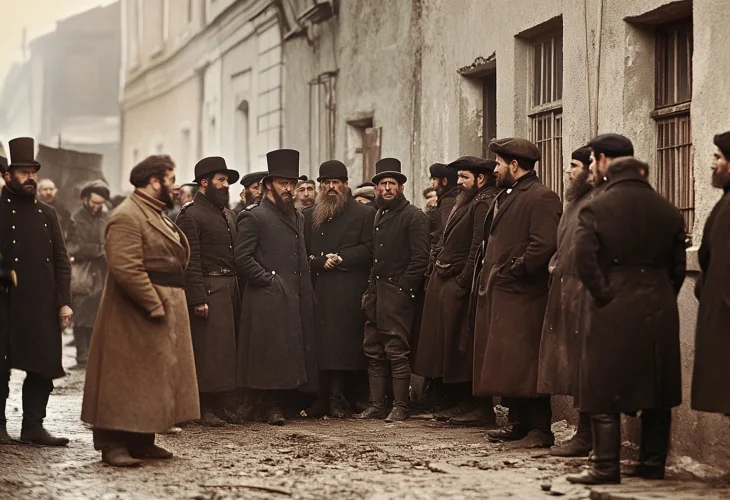History and Archaeology
When Dressing Jewish Became Illegal in Tsarist Russia
In 1840s Russia, Jews were fined for yarmulkes and attacked for beards. The fight for Jewish dress lives on to this day

In 1841, a gathering of rabbis from across the Russian Empire was called to discuss the state of Jewish communities and report back to the government under Tsar Nicholas I.
But “rabbis” in those days didn’t all share the same beliefs. Some were great Torah scholars and faithful halachic authorities. Others were more modern or “enlightened,” pushing for reforms in Jewish life. These more progressive voices believed that traditional Jewish clothing made Jews stand out, stirred antisemitism, and encouraged a “foreign” way of living. They wanted Jews to look and behave more like Russians.
Some of these rabbis approached Sergey Uvarov, Russia’s Minister of Enlightenment, and suggested banning traditional Jewish clothing altogether. Thankfully, true Torah leaders like Rabbi Yitzchak of Volozhin (son of Rabbi Chaim of Volozhin and student of the Vilna Gaon) and the Tzemach Tzedek of Chabad strongly opposed the idea and explained that the reform-minded rabbis represented only a small minority. As a result, the ban was temporarily delayed.
But the idea had already started spreading through government circles. Just three years later, in 1844, Tsar Nicholas issued the infamous "clothing decrees."
These new laws required Jews to wear short modern coats instead of long traditional ones. Jews were also forbidden from growing side curls (payot) or beards. Wearing a yarmulke (kippah) came with a yearly fine of 5 rubles and was only allowed for rabbis. Jews were permitted to wear traditional clothing to synagogue on Shabbat, but not during the week.
While there was supposed to be a five-year grace period before full enforcement, the authorities didn’t wait. Police and “enlightened” citizens publicly attacked religious Jews, cutting off their payot and beards in the streets.
Rabbi Yaakov Lipschutz, who served as the secretary to Rabbi Yitzchak Elchanan Spector, described the horrific scenes he witnessed in his hometown of Wilkomir:
“Police officers pounced on Jews like wild animals. They cut off their hair with axes instead of scissors, sometimes slicing part of the ear with it. They shredded their clothing with saws when knives weren’t available and beat them repeatedly.”
Many Jews hoped the decree would pass and tried to avoid police or bribe them. But reports from towns like Prashnitz and Tsekhinow told of elders being dragged off, as Rabbi Shraga Feivel of Grodzhisk wrote in 1847:
“Now and then, by Hashem (the local policeman)... in other towns, there are aids for evil... and most of the elders of our people have already been taken away, may Hashem have mercy.”
This led to a serious halachic debate among the greatest Torah leaders of the time.
Hasidic rabbis believed the decrees were a form of religious persecution intended to make Jews abandon their faith. According to the Talmud, in such cases, one must be willing to sacrifice their life rather than comply. Leading figures like Rabbi Israel of Ruzhin, Rabbi Yitzchak of Vorka, and the Chidushei HaRim fought fiercely to preserve traditional Jewish dress.
On the other hand, many Lithuanian rabbis felt that the goal of the decrees wasn’t to destroy Judaism, but to encourage assimilation. They ruled that while the decrees were painful and unjust, Jews did not have to give up their lives over the issue.
This halachic disagreement led to visible differences that remain today.
Hasidim continued wearing long coats (kapotes) and shtreimels (fur hats) on Shabbat, which the decree had technically allowed.
During the week, they fought to keep wearing long coats, as a sign of loyalty to the traditions they had risked so much to defend.
Lithuanian Jews, who had already adapted to modern clothing, continued dressing in more modern European styles.
In 1851, the authorities tried to pressure the Hasidic leader Rabbi Yitzchak Meir Alter, known as the Chidushei HaRim and founder of the Ger Hasidic dynasty. They saw him as a major obstacle to enforcing the decree.
At midnight on the 7th of Nisan, he was arrested. The goal was to force him to sign a document urging Hasidim to accept the new dress code. Instead, thousands of Hasidim took to the streets in protest. Their outcry worked: Rabbi Yitzchak Meir was released the next day.
Tsar Nicholas went on to pass more than 600 anti-Jewish laws, but in 1855, during the joyous holiday of Purim, the evil ruler died and the clothing decree was canceled.
But the divide remained. Hasidim held on to the traditional clothing they had fought so hard to protect, while Lithuanian Jews continued with their newer attire.
This difference, born out of suffering and spiritual conviction, can still be seen today in Shabbat garments, long coats, and the deep pride in Jewish tradition.

